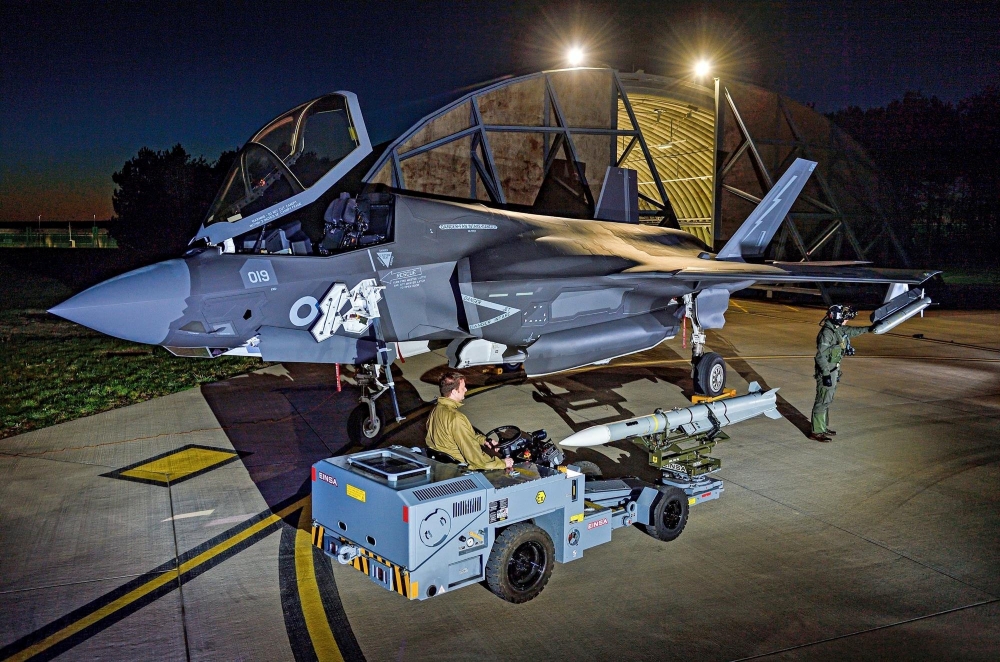
The National Audit Office released a report on the United Kingdom F-35 capability, highlighting that while the stealth jet brings superior military capability, the Lightning Force remains plagued by low availability caused by insufficient spare parts, lack of key personnel and infrastructure.
While availability remains a concern for every Lockheed Martin F-35 user, the NAO found that UK availability rates are below the global F-35B rates and the Joint Project Office’s metrics due to specific UK failures in appropriately managing and resourcing the programme.
The report does not disclose exact percentages in terms of availability but notes that the now 37-strong fleet of F-35B jets has flown 3,106 hours in 2024. In 2024 the UK F-35 fleet had a mission capable rate (defined as the ability of an aircraft to perform at least one of its seven possible required missions) which was approximately half of the MoD’s target.
The full mission capable rate, (defined as the ability of an F-35 aircraft to perform all its required missions) only reached approximately one-third of the MoD’s target, and the NAO further cautions that UK targets are already lower than global targets set by the JPO.
“The poor availability rates are driven largely by a UK shortage of F-35 engineers and a global shortage of F-35 spare parts”, the NAO further notes.
The requirement for engineers was underestimated and action to correct the low allocation of specialists has been slow: the recruitment of another 168 engineers is now funded, but is not expected to deliver before 2028. There is also concern on the availability of suitably prepared cyber specialists.
There are also shortages of pilots and flying instructors, with 207 Squadron, the Operational Conversion Unit, having 6 qualified instructors against a requirement for 16. These gaps partly reflect MoD-wide shortages, but the F-35 force is especially affected because it is “perceived by some Royal Air Force personnel as a comparatively unattractive posting because of long Carrier deployments”, something that calls into question, yet once more, the decision of creating a “Joint Force” in the first place.
Another issue is that accommodation for service personnel in Marham, the operating base for the type, is in poor state, enough to affect retention. The situation is serious enough that 200 temporary accommodation units at RAF Marham are to be built by September 2025, but serious work is required to bring accommodation up to modern standards and also to provide some basic services, including a better gym. It must be noted that several projects for new build or refurbished Single Living Accommodations for Marham were supposed to be launched in these months under the April 2024 MOD Procurement Pipeline. Those projects were no longer listed in the October (and last) version of the Pipeline to be published, adding to fears that further delays in funding the works have piled up.
Infrastructure is also lacking. Under Project ANVIL, beginning in 2013, the MOD built 4 of the key infrastructures needed to operate F-35B autonomously in and from Marham: Integrated Training Centre, the Lightning Operations Centre, the Maintenance Repair Upgrade and Finish Facility were build in Marham specifically and were accompanied by the refurbishment of 12 2-aircraft Hardened Aircraft Shelter, the provision of external “sun shelters”, the resurfacing of runways and taxiways and the construction of 3 vertical landing pads. The fourth key structure is the Australia Canada and UK Reprogramming Laboratory (ACURL) mission planning reprogramming lab at Edwards AFB, in the US.
A fifth key structure has yet to be built, however, despite being in the plans since 2016: an Aircraft Signature Assessment Facility (ASAF) is the final requirement to attain UK freedom of action. Despite setting a £151 million budget for the facility in 2016, intending for it to be in operation by 2021, the MoD ended up delaying the project for short term affordability measures and will now not deliver the ASAF until the 2030s.
The MoD is now considering building a joint ASAF for the F-35 and the Global Combat Air Programme (GCAP), but in the meantime, as a partial stopgap, plans are being crafted to send 2 aircraft a year to the ASAF facility in Italy.
Moreover, despite standing up 809 Naval Air Squadron in December 2023 as the second frontline F-35 unit, the MoD failed to fund infrastructure work to properly accommodate its needs. As a consequence, 809 “does not currently have permanent facilities including hangars and tool stores, instead using temporary portacabins and sharing facilities with 617 Squadron. This prevents 809 NAS from controlling its engineering programme and risks being unsustainable as more aircraft are delivered”. The contract for the necessary infrastructure is not expected before next year.
On spare parts, the NAO puts much emphasis on the global shortage of spare parts for F-35, but the UK has made its own position worse by procuring just 2 Deployable Spares packs, one of which “Lite” with a reduced stock, meant for “land use only”. We must also observe another factor the NAO does not touch: unlike other countries, the UK has also elected not to buy a single spare engine to store autonomously, heightening its dependency on the Global management of spares.
The NAO also touches on well known delays to weapon integration. While PAVEWAY IV and ASRAAM are operational, SPEAR 3 and METEOR are now only expected in the “early 2030s” after repeated delays.
SPEAR 3 is in large measure responsible for its own delay, with the NAO noting that development of the new weapon has been “delayed by poor supplier performance partly resulting from lack of suitably qualified and experienced people", although it is also waiting on "a key component from the US".
New guided drop trials are planned in Sweden, from a TYPHOON, for this summer but SPEAR 3 is badly lagging against its original timeframe. METEOR is more mature as a weapon but its integration is delayed by the JPO not providing enough opportunities for flight testing, as instrumented jets are already overworked with the wider, delayed Block 4 activities. While METEOR finally first flew on a (USMC instrumented) F-35B last year, integration will require years still.
The lack of METEOR is at least well mitigated by the availability of AIM-120D AMRAAM, with the UK having been authorized to procure 200 such weapons in July 2018. Since then, the UK has ordered (undisclosed) numbers of missiles in production Lots 32, 33, 36, 37 and 38.
The lack of a stand-off surface strike weapon is instead a concern and the Lightning Force has asked the MOD to procure a stock of US Small Diameter Bombs. The MOD has not yet authorized funding for this procurement, however.
Not even the NAO has been given any detail about the timetable of orders for the next 27 jets (Tranche 2) so it remains impossible to say how they will be spread across the next F-35 production lots. As we know, under the latest plan, 12 of the jets will be F-35A destined to the OCU Sqn and 15 will be F-35B, to support the formation of the third frontline Sqn by 2033.
Obviously, given the "last minute" nature of the F-35A decision, the NAO report could only hastily add 2 paragraphs about this new procurement decision. It didn’t have any time or chance to actually look into the assumptions behind it. Naturally there is no information whatsoever about when any of the other 63 jets the UK is in theory committed to procure would be acquired. The hope is that the Defence Investment Plan, expected in the Autumn, will finally have something meaningful to say. The NAO quietly The NAO notes that the "discrepancy" between the big returns for UK industry and the glacially slow and uncertain pace of aircraft procurement by the UK "has been noted by partners" so that "the UK’s relationship with the global programme had been put at risk".








.png)
